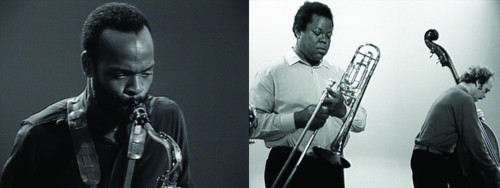
Stan Douglas. “Hors-champs,” 1992. Two-channel video installation with stereo sound; 13:20 minutes. Courtesy of the artist and David Zwirner Gallery, New York. Image courtesy of the artist and David Zwirner Gallery, New York. © Stan Douglas
“The blues,” Ralph Ellison wrote in 1945, “is an impulse to keep the painful details and episodes… alive in one’s aching consciousness, to finger its jagged grain, and to transcend it, not by the consolation of philosophy but by squeezing from it a near-tragic, near-comic lyricism.” Or as Langston Hughes put it, it’s “the kind of humor that laughs to keep from crying.”
Through April 28, the Whitney Museum of American Art is presenting Blues for Smoke, a wide-ranging exhibition exploring the definition of the blues and blues aesthetic, the history and origins in the South at the turn of the twentieth century, the sensibility, the vernacular, the music, through the visual arts. As a theme, it’s enormous, especially for a mainly one-floor show, and it asks that you simultaneously hold in your mind the vastness of the concept of blues and its various manifestations, as well as the experience of these individual works of art. Trying to make all these connections can feel like a strain, out of step with the experience of the blues, its emotional heart, as Ellison had it.
Yet the exhibition also manages to be, in many ways, very subtle—powerfully quiet and nuanced, and the omnipresent jazz and blues playing in the background create a reflective mood in which to experience the work. Blues for Smoke is also a prime chance to see many fine artists assembled together, deeply and individually engaged with the various aspects of the subject.

Jack Whitten. “Black Table Setting (Homage to Duke Ellington),” 1974. Acrylic on canvas. Collection of the Art Fund, Inc. at the Birmingham Museum of Art; Purchase with funds provided by Jack Drake and Joel and Karen Piassick.
Kara Walker contributes one of the more viscerally painful works, the video Fall Frum Grace: Miss Pipi’s Blue Tale (2011), a brutal account of the trials of her heroine in the antebellum South. The precision and exacting skill in Walker’s shadow figure cutouts, their emotional evocativeness, is heightened by the deliberate crudeness of the puppetry—the choppy filming, Walker’s hands sometimes coming into view as she works the horrendous acts of rape and sadism against the slow, mournful music. A series of Romare Bearden’s collages from the mid-1960s depicts the Great Migration from South to North, and the splintering of the individual and of communities. Pittsburg Memory (1964), in particular, so fully captures the genius of what Bearden was able to do—visually conveying, in collaged fragments and pieces, a very true and holistic portrait of the experience of human consciousness. It’s nicely paired with the outsized expressiveness and humor of John Outterbridge’s California Crosswalk (1979), one of his colorful, large-bodied figures made from scraps of wire and rags, sitting in a big-wheeled chrome car.
Melvin Edwards’s welded metal wall sculptures, part of the Lynch Fragments series, complicated, densely sad, frightening, intractable, are installed alongside Zoe Leonard’s Untitled (1994–97). Leonard arranged, on a platform, desiccated little pieces of fruit—what was once an orange, a banana—their skins carefully sewn up to cover where the juiciness of the fruit once was. Referencing both Billie Holiday’s protest song, “Strange Fruit,” as well as the ravages of grief, it’s a delicate and moving work.
The final room explores music’s expression and range in relationship to painting. Jack Whitten has two large abstract canvases here. Black Table Setting (Homage to Duke Ellington) (1974) is a visual translation of John Coltrane’s “sheets of sound,” utilizing an experimental process Whitten learned in residence at the Xerox corporation in the 1970s. It’s fascinating to then turn around and see Mark Bradford’s Weather (2006), which feels so hyper-articulate visually, in the context of sound and its shapes.
The blues, more than anything, enact a powerful process of transformation, turning raw suffering into creative expression, suggesting the human capacity to transcend life’s painful realities. There is an essential mystery locked within that state of grace. As Coltrane said of his music in 1962, “I would love to discover a process such that if I wanted it to rain, it would start raining. If one of my friends were sick, I would play a certain tune and he would get better; if he were broke, I would play another tune and immediately he would receive all the money he needed. But what those pieces are, and what way do you have to go to arrive at knowing them, I don’t know.”
Blues for Smoke is at the Whitney Museum of American Art in New York through April 28.



